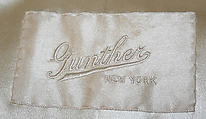Evening cape
Designer H. Jaeckal & Sons American
Not on view
Medieval and Renaissance sumptuary legislation ensured that the pelts of finer, rarer, and smaller animals, such as ermine and marten, were reserved for the nobility, giving rise to one of the enduring stereotypes of the fur-clad man or woman-the aristocrat. Ermine came to be a potent signifier of royalty, used to line the coronation robes of kings and queens, as exemplified in Hyancinthe Rigaud's painting of Louis XIV (1701). Ermine reached its height of fashionability in the 1920s and 1930s, when it was used for long and short evening capes, hung effortlessly from the shoulders of bourgeois and aristocratic women. More than any other fur, ermine has a delicacy and fineness that allows a clothlike drape.
Due to rights restrictions, this image cannot be enlarged, viewed at full screen, or downloaded.
This artwork is meant to be viewed from right to left. Scroll left to view more.




